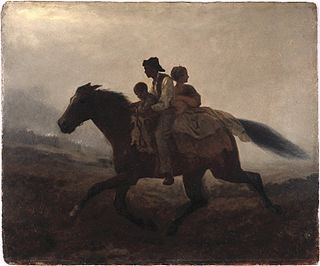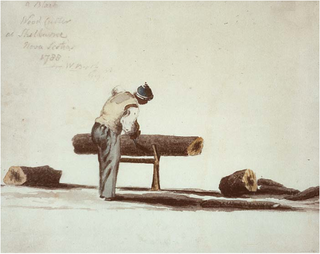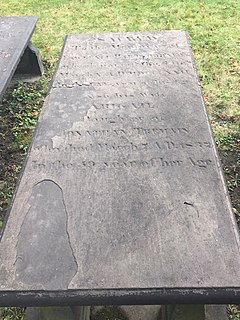| African Nova Scotian English | |
|---|---|
| Region | Nova Scotia (primary), diaspora populations in New Brunswick and Greater Toronto Area |
Indo-European
| |
| Language codes | |
| ISO 639-3 | – |
African Nova Scotian English (ANSE and ANSD) is a variety of the English language spoken by descendants of black immigrants from the United States who live in Nova Scotia, Canada. Members of these communities are collectively known as Black Nova Scotians. [1]

English is a West Germanic language that was first spoken in early medieval England and eventually became a global lingua franca. It is named after the Angles, one of the Germanic tribes that migrated to the area of Great Britain that later took their name, as England. Both names derive from Anglia, a peninsula in the Baltic Sea. The language is closely related to Frisian and Low Saxon, and its vocabulary has been significantly influenced by other Germanic languages, particularly Norse, and to a greater extent by Latin and French.

The United States of America (USA), commonly known as the United States or simply America, is a country comprising 50 states, a federal district, five major self-governing territories, and various possessions. At 3.8 million square miles, it is the world's third or fourth largest country by total area and is slightly smaller than the entire continent of Europe. Most of the country is located in central North America between Canada and Mexico. With an estimated population of over 327 million people, the U.S. is the third most populous country. The capital is Washington, D.C., and the most populous city is New York City.

Nova Scotia is one of Canada's three Maritime Provinces, and one of the four provinces that form Atlantic Canada. Its provincial capital is Halifax. Nova Scotia is the second-smallest of Canada's ten provinces, with an area of 55,284 square kilometres (21,300 sq mi), including Cape Breton and another 3,800 coastal islands. As of 2016, the population was 923,598. Nova Scotia is Canada's second-most-densely populated province, after Prince Edward Island, with 17.4 inhabitants per square kilometre (45/sq mi).
Though most African American freedom seekers in Canada ended up in Ontario through the Underground Railroad, only the dialect of African Nova Scotians retains the influence of West African pidgin. [2] In the 19th century, African Nova Scotian English would have been indistinguishable from English spoken in Jamaica or Suriname. [3] However, it has been increasingly de-creolized since this time, due to interaction and influence from the white Nova Scotian population, who mostly hail from the British Isles. Desegregation of the province's school boards in 1964 further accelerated the process of de-creolization. The language is a relative of the African-American Vernacular English, with significant variations unique to the group's history in the area. [4] [5] There are noted differences in the dialects of those from Guysborough County (Black Loyalists), and those from North Preston (Black Refugees), the Guysborough group having been in the province three generations earlier. [5]

The phenomenon of slaves running away and seeking to gain freedom is as old as the institution of slavery itself. In the history of slavery in the United States, "fugitive slaves" were slaves who left their master and traveled without authorization; generally they tried to reach states or territories where slavery was banned, including Canada, or, until 1821, Spanish Florida. Most slave law tried to control slave travel by requiring them to carry official passes if traveling without a master.

The Underground Railroad was a network of secret routes and safe houses established in the United States during the early to mid-19 century, and used by enslaved African-Americans to escape into free states and Canada. The scheme was assisted by abolitionists and others sympathetic to the cause of the escapees. Not literally a railroad but rather a secretly organized means of movement, the workers both black and white, free and enslaved, who aided the fugitives can also be referred to as the "Underground Railroad". Various other routes led to Mexico, where slavery had been abolished, or overseas. An earlier escape route running south toward Florida, then a Spanish possession, existed from the late 17th century until Florida became a United States territory in 1821. One of the main reasons Florida was purchased by the United States was to end its function as a safe haven for escaped slaves. However, the network now generally known as the Underground Railroad was formed in the late 1700s. It ran north and grew steadily until the Civil War began. One estimate suggests that by 1850, 100,000 slaves had escaped via the "Railroad".

The British Isles are a group of islands in the North Atlantic off the north-western coast of continental Europe that consist of the islands of Great Britain, Ireland, the Isle of Man, the Hebrides and over six thousand smaller isles. They have a total area of about 315,159 km2 and a combined population of almost 72 million, and include two sovereign states, the Republic of Ireland, and the United Kingdom of Great Britain and Northern Ireland. The islands of Alderney, Jersey, Guernsey, and Sark, and their neighbouring smaller islands, are sometimes also taken to be part of the British Isles, even though, as islands off the coast of France, they do not form part of the archipelago.
Howe & Walker (2000) use data from early recordings of African Nova Scotian English, Samaná English, and the recordings of former slaves to demonstrate that speech patterns were inherited from nonstandard colonial English. [6] The dialect was extensively studied in 1992 by Shana Poplack and Sali Tagliamonte from the University of Ottawa. [5]
Samaná English is a variety of the English language spoken by descendants of black immigrants from the United States who have lived in the Samaná Peninsula, now in the Dominican Republic. Members of the enclave are known as the Samaná Americans.
A commonality between African Nova Scotian English and African American Vernacular English is (r)-deletion. This rate of deletion is 57% among Black Nova Scotians, and 60% among African Americans in Philadelphia. Meanwhile, in the surrounding mostly white communities of Nova Scotia, (r)-deletion does not occur. The exception to this is the non-rhotic dialect of Lunenburg English. [7]
Rhoticity in English is the pronunciation of the historical rhotic consonant in all contexts by speakers of certain varieties of English. The presence or absence of rhoticity is one of the most prominent distinctions by which varieties of English can be classified. In rhotic varieties, the historical English sound is preserved in all pronunciation contexts. In non-rhotic varieties, speakers no longer pronounce in postvocalic environments—that is, when it is immediately after a vowel and not followed by another vowel. For example, a rhotic English speaker pronounces the words hard and butter as /ˈhɑːrd/ and /ˈbʌtər/, whereas a non-rhotic speaker "drops" or "deletes" the sound, pronouncing them as /ˈhɑːd/ and /ˈbʌtə/. Other terms synonymous with "non-rhotic" include "-deleting", "r-dropping", "r-vocalizing", and "r-less"; synonyms for "rhotic" include "-pronouncing" and "r-ful".
Lunenburg English is a moribund, German-influenced dialect of English, spoken in the town of Lunenburg and Lunenburg County in the province of Nova Scotia. It is sometimes called "Lunenburg Dutch". The dialect shows unique features in pronunciation, e.g. unusual handling of rhotic consonants, in syntax and vocabulary, which portray the various sociohistorical influences.








